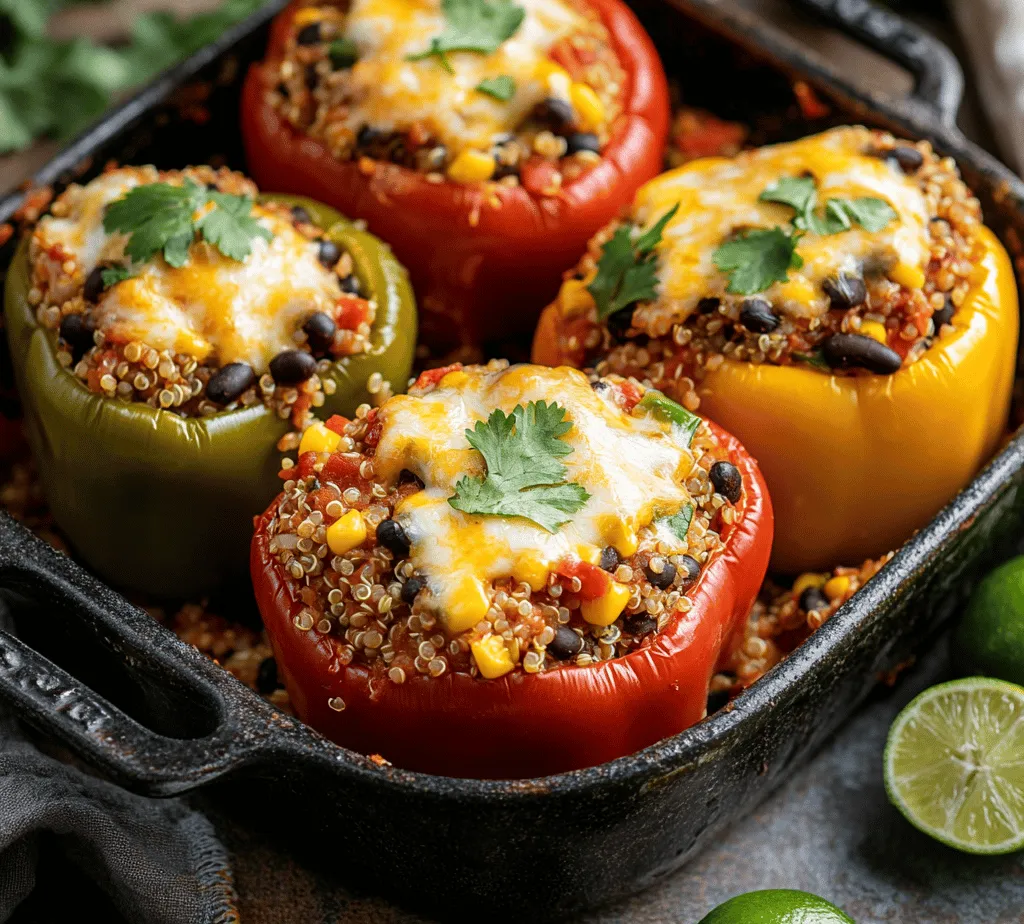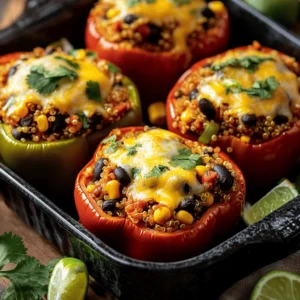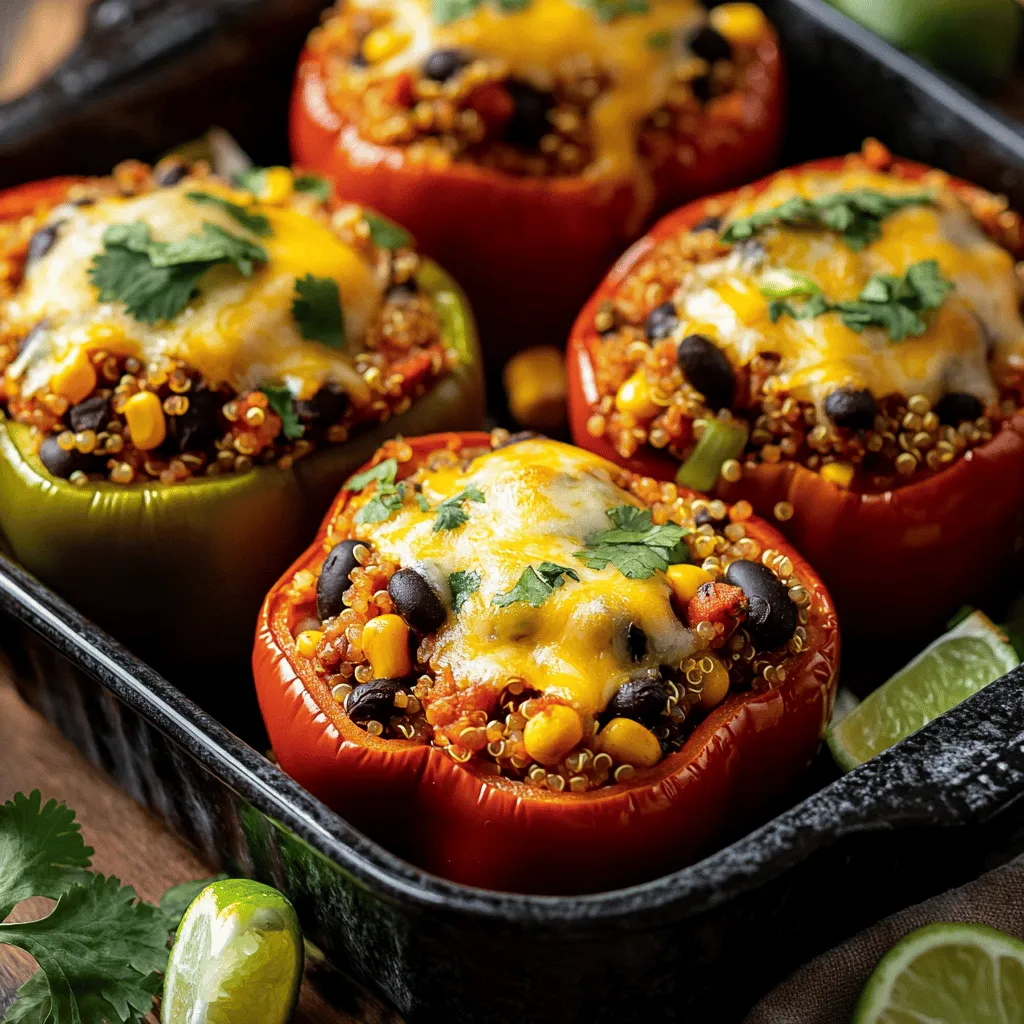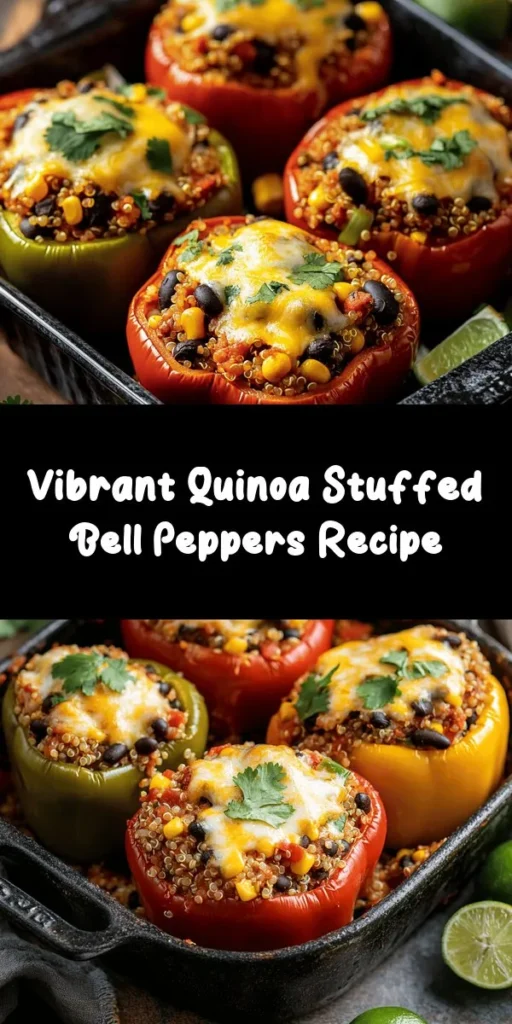Introduction
Stuffed bell peppers have long been a beloved dish across various cuisines, celebrated for their vibrant colors, versatility, and hearty nature. These delightful vegetable vessels are not only visually appealing but also incredibly adaptable, allowing cooks to create a multitude of flavors based on personal preferences and dietary requirements. Whether you’re serving them at a family dinner, a casual gathering, or as a meal prep option for the week ahead, stuffed bell peppers can cater to all occasions.
Introducing the “Stuffed Bell Pepper Delight,” this recipe brings together a medley of nutritious ingredients that create a wholesome meal, perfect for everyone—from vegans to meat-lovers. Each bite is a burst of flavor, combining the sweetness of bell peppers with a savory filling that includes quinoa, black beans, and spices, offering a balanced profile of nutrients. The dish is not only satisfying but also a great way to incorporate more vegetables into your diet, making it an excellent choice for health-conscious individuals.
This recipe stands out due to its rich blend of flavors and textures. As you dive into the cooking process, you’ll discover how easy it is to create a dish that is both nourishing and indulgent. Let’s explore the ingredients that make “Stuffed Bell Pepper Delight” a standout recipe, and then we will guide you through the initial steps required to prepare this delightful meal.
Understanding the Ingredients
The secret to a successful stuffed bell pepper lies in the quality and selection of ingredients. Here’s a closer look at the key components of this recipe and their health benefits:
Bell Peppers
Bell peppers are the star of this dish, not only adding a pop of color but also packing a nutritional punch. They are rich in vitamins A and C, both of which are essential for maintaining a healthy immune system and promoting skin health. Additionally, bell peppers contain antioxidants that can help combat oxidative stress in the body. The sweetness of the peppers enhances the overall flavor of the dish, creating a perfect balance with the savory filling.
Quinoa
Quinoa is a gluten-free grain that serves as a complete protein source, meaning it contains all nine essential amino acids. This makes it an excellent choice for those following vegetarian or vegan diets. Quinoa is also high in fiber, which aids digestion and helps maintain a feeling of fullness. When cooked properly, quinoa has a light, fluffy texture that complements the other ingredients in the stuffed peppers beautifully.
Black Beans
Black beans are another powerhouse ingredient in this recipe. They are high in protein and fiber, making them a hearty addition that helps to keep you satiated. Additionally, black beans are rich in antioxidants, vitamins, and minerals, including iron and magnesium, which are essential for overall health. Their creamy texture and earthy flavor provide a wonderful contrast to the crispness of the bell peppers.
Corn
Corn adds a delightful natural sweetness to the filling, along with an extra layer of nutrients. It is a good source of fiber and essential vitamins, including B vitamins that play a role in energy metabolism. The addition of corn not only enhances the flavor profile but also contributes to the overall texture of the dish, creating a satisfying bite.
Spices
To elevate the flavors of the stuffed bell peppers, a blend of spices such as cumin, paprika, and chili powder is used. Cumin adds a warm, nutty flavor that pairs well with the other ingredients, while paprika lends a mild smokiness. Chili powder can be adjusted to taste, providing the option to spice things up if desired. The right blend of spices is key to making the filling vibrant and tasty.
Importance of Fresh Ingredients
Using fresh, high-quality ingredients is crucial for achieving the best results in any recipe. Fresh vegetables not only taste better but also retain more nutrients. When selecting bell peppers, look for ones that are firm and unblemished. Similarly, choosing organic quinoa and beans can enhance the nutritional value and flavor of the dish. Fresh herbs, if used, can also elevate the taste and aroma of your stuffed peppers.
Step-by-Step Guide to Making Stuffed Bell Pepper Delight
Now that we have a better understanding of the ingredients, it’s time to dive into the preparation process. Here’s a detailed step-by-step guide to help you create your own Stuffed Bell Pepper Delight.
Preparing the Oven
Before you start cooking, it’s essential to prepare your oven. Preheating your oven to 375°F (190°C) is a crucial step that ensures even cooking throughout the dish. Skipping this step can result in unevenly cooked peppers, with some parts overcooked while others remain raw. By allowing the oven to reach the desired temperature before placing the stuffed peppers inside, you ensure that they will roast perfectly, enhancing their natural sweetness and flavor.
Cooking the Quinoa
The next step involves cooking the quinoa. Begin by measuring out one cup of quinoa and rinsing it under cold water in a fine-mesh strainer. Rinsing quinoa is important as it helps remove its natural coating, known as saponin, which can impart a bitter taste if not washed away.
Once rinsed, transfer the quinoa to a medium saucepan. Add two cups of water or vegetable broth for added flavor. Bring the mixture to a boil over medium-high heat. Once boiling, reduce the heat to low, cover the saucepan, and let it simmer for about 15 minutes or until the quinoa has absorbed all the liquid. The grains should appear fluffy and the germ ring will separate, indicating that they are cooked. Remove the saucepan from heat and let it sit covered for an additional 5 minutes before fluffing it with a fork. This will ensure the quinoa has the perfect texture for your stuffed peppers.
Sautéing the Vegetables
While the quinoa is cooking, it’s time to sauté the vegetables. Start by chopping one medium onion and two cloves of garlic. In a large skillet, heat a tablespoon of olive oil over medium heat. Once the oil is hot, add the chopped onion and sauté for about 3-4 minutes until the onions become translucent and fragrant.
Next, add the minced garlic to the skillet and continue to sauté for an additional minute, being careful not to let it burn. Garlic can quickly turn bitter if overcooked, so keep a close eye on it. The combination of sautéed onions and garlic will create a flavorful base for your filling.
After the onions and garlic are ready, add in one cup of corn and one can (15 ounces) of drained and rinsed black beans. Stir these ingredients into the skillet and season with a teaspoon of cumin, a teaspoon of paprika, and a pinch of chili powder. Sauté for another 2-3 minutes until everything is heated through and well combined. Adjust the seasoning according to your taste preferences, adding salt and pepper as needed.
Combining the Filling Ingredients
Once the sautéed vegetable mixture is ready, it’s time to combine it with the cooked quinoa. In a large mixing bowl, add the cooked quinoa and the sautéed vegetables along with a handful of chopped fresh herbs, such as cilantro or parsley if desired. Gently stir the mixture until all ingredients are evenly incorporated, ensuring that the flavors are distributed throughout the filling. The contrast between the fluffy quinoa, creamy black beans, and sweet corn will create a deliciously textured filling.
Preparing the Bell Peppers
Now that your filling is ready, it’s time to prepare the bell peppers. Choose four medium-sized bell peppers, preferably in a mix of colors for a visually appealing dish. Start by cutting the tops off the peppers and removing the seeds and membranes inside. This can be done by slicing off the top about an inch from the stem, creating a “lid” that can be set aside to use later if desired. Use a small knife or spoon to carefully scoop out the insides, taking care not to puncture the walls of the peppers.
Once cleaned, place the bell peppers upright in a baking dish. This will allow them to stand firm while they bake and prevent any filling from spilling out. If you prefer a slightly softer pepper, you can lightly blanch them in boiling water for a few minutes before stuffing them, but this step is optional.
With the bell peppers prepared and the filling ready, you’re now set to assemble your Stuffed Bell Pepper Delight.
(Continued in the next part…)

Tips for Ensuring Peppers Stand Upright During Baking
When preparing stuffed bell peppers, one of the most common challenges is ensuring they stand upright during baking. A stable pepper means even cooking and a visually appealing presentation. Here are some effective tips:
1. Trim the Bottoms: Carefully trim a small slice off the bottom of each pepper. This will create a flat base that helps them stand without tipping over. Be cautious not to cut too deep, as you don’t want to create holes that allow the stuffing to spill out.
2. Use a Muffin Tin: Place the peppers in a muffin tin. The individual cups will cradle the peppers, preventing them from wobbling and allowing for even cooking.
3. Add Rice or Quinoa: If you’re using cooked rice or quinoa in your stuffing, you can add a little extra to the bottom of the pepper before filling it. This creates a base that adds stability while enhancing the flavor.
4. Parboil the Peppers: Briefly boiling the peppers before stuffing them can soften their skin and make them more pliable. This can help the peppers maintain their shape during baking.
Stuffing the Peppers
Once your peppers are stable, it’s time to stuff them with the delightful mixture. Here’s how to achieve the best results:
1. Best Practices for Filling and Packing the Mixture: When filling the peppers, it’s essential to pack the stuffing tightly without overstuffing. This ensures the filling holds together and creates a hearty bite. Use a spoon to push the mixture down gently, but avoid compressing it too much, as you want some air for even cooking.
2. Visual Cues for Proper Stuffing Techniques: The ideal stuffing should be just below the top of the pepper. If you’re using cheese as a topping, leave a little space at the top for it to melt without overflowing. Remember, a well-stuffed pepper should look generously filled but not bulging.
Topping with Cheese
Cheese is often the crowning glory of stuffed bell peppers. Here’s how to choose and apply it effectively:
1. Choosing the Right Cheese for Flavor and Meltability: Opt for cheeses that melt well and complement your filling. Mozzarella, cheddar, and Monterey Jack are excellent choices. For a gourmet touch, consider Gruyère or fontina, which add depth of flavor. If you prefer a dairy-free option, try plant-based cheeses made from nuts or soy.
2. Application Technique: After stuffing the peppers, sprinkle the cheese evenly on top. For a cheesier experience, mix different cheeses together. If you’re feeling adventurous, add a sprinkle of paprika or chili flakes for an extra kick.
Baking the Stuffed Peppers
Baking is where the magic happens, transforming the raw ingredients into a delicious meal. Consider the following steps:
1. Importance of Covering and Uncovering for Optimal Cooking Results: Start by covering the stuffed peppers with aluminum foil. This traps steam, helping the peppers cook through without drying out. After about 25 minutes, remove the foil to allow the cheese to brown and create a delicious crust.
2. Timing for Achieving the Perfect Balance of Tenderness and Cheese Texture: Bake the stuffed peppers at 375°F (190°C) for approximately 30-40 minutes. Check for tenderness by inserting a fork into the pepper; it should pierce easily. The cheese should be bubbly and golden brown, indicating it’s ready to be served.
Garnishing and Serving
Garnishing adds a touch of elegance and freshness to your dish. Here are some ideas:
1. Suggestions for Garnishing with Herbs for Freshness: Fresh herbs like parsley, cilantro, or basil can elevate the flavor of your stuffed peppers. A sprinkle of chopped herbs right before serving adds color and a burst of freshness.
2. Ideas for Serving with Lime Wedges and Creating a Beautiful Presentation: Serve your stuffed peppers on a colorful platter with lime wedges on the side. The acidity of lime juice complements the richness of the cheese and stuffing, enhancing the overall flavor. For an appealing presentation, consider adding a bed of greens, like arugula or spinach, underneath the peppers.
Nutritional Analysis of Stuffed Bell Pepper Delight
Understanding the nutritional value of your meal is essential for maintaining a balanced diet.
1. Breakdown of Calories, Macronutrients, and Vitamins Per Serving: One serving of stuffed bell pepper typically contains around 300-400 calories, depending on the filling and cheese used. Each pepper can provide approximately 20 grams of protein, 40 grams of carbohydrates, and 10 grams of fat. They are also rich in vitamins A and C, fiber, and antioxidants.
2. Explanation of How This Dish Fits into a Balanced Diet: Stuffed bell peppers are not only nutritious but also versatile. They can serve as a main dish or a side, providing a healthy balance of protein, carbs, and fats. The inclusion of vegetables ensures you’re getting essential nutrients while keeping the meal light and satisfying.
3. Discussion of Dietary Adaptations: To cater to various dietary needs, consider making substitutions. For a vegan version, use lentils or chickpeas as the protein source, and opt for nutritional yeast or a vegan cheese alternative. For a gluten-free adaptation, ensure that all grains and fillers are gluten-free certified.
Cultural Significance of Stuffed Peppers
Stuffed peppers hold a special place in culinary traditions worldwide, reflecting the cultural significance of this beloved dish.
1. Exploration of Different Cultural Variations: Across continents, stuffed peppers are prepared in diverse ways. In Hungary, they are filled with rice and minced meat, often served with a savory sauce. In the Middle East, they may be stuffed with spiced rice and vegetables, showcasing regional spices and flavors.
2. Historical Context: The origins of stuffed peppers can be traced back to ancient civilizations where various vegetables were used for stuffing. Over time, this dish has evolved, adapting to local ingredients and cooking methods, making it a staple in many households.
3. The Role of Stuffed Peppers in Family Traditions: Stuffed peppers often appear in family gatherings and celebrations, symbolizing comfort and togetherness. Preparing them can be a communal activity, bringing families together to share stories and enjoy a delicious meal.
Creative Variations and Customizations
The beauty of stuffed peppers lies in their versatility. Here are some ideas for creative variations:
1. Suggestions for Alternative Fillings: While traditional fillings often consist of rice and ground meat, consider alternatives like quinoa, couscous, or even grains like farro for a unique texture. For a vegetarian option, you can use tofu or tempeh sautéed with spices.
2. Ideas for Adding Extra Vegetables or Spices: Enhance the flavor profile by adding chopped spinach, zucchini, or mushrooms to the filling. Experiment with spices such as cumin, coriander, or smoked paprika to create a distinctive taste.
3. Recommendations for Different Types of Cheese or Plant-Based Alternatives: If you want to personalize your dish even further, try using feta cheese for a tangy flavor or a blend of cheeses for a more complex taste. For a plant-based option, look for vegan cheeses that melt well, or consider using cashew cream for a creamy topping.
Conclusion
“Stuffed Bell Pepper Delight” is more than just a meal; it’s a celebration of flavors, nutrition, and cultural heritage. With its vibrant colors and delicious taste, this dish is perfect for family dinners, meal prep, or entertaining guests. Not only does it provide essential nutrients, but it also invites creativity and personalization in the kitchen.
As you explore this recipe, consider experimenting with different fillings, spices, and garnishes to make it your own. The joy of cooking is not just in the final product but in the journey of creating something wholesome and delicious to share with loved ones. Embrace the art of stuffed peppers, and let them become a cherished staple in your meal planning repertoire.



